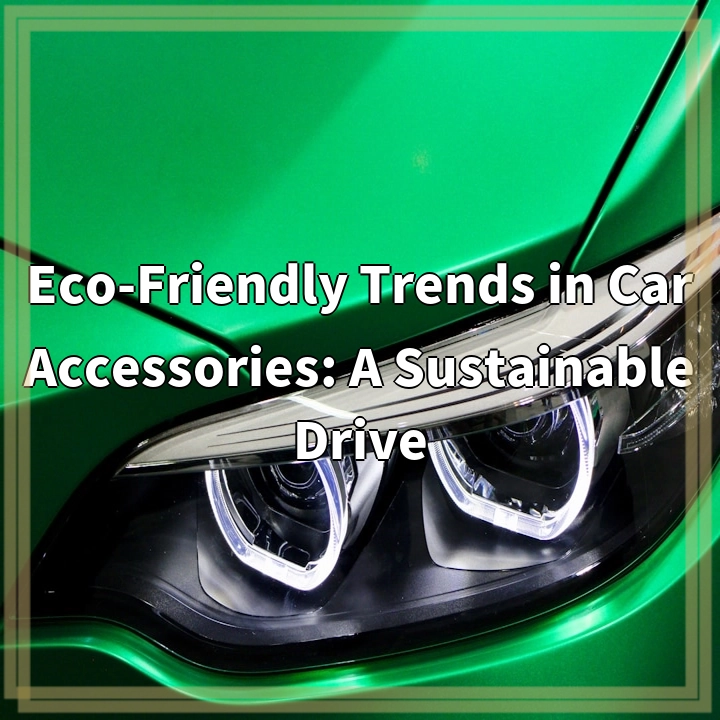
What it is:
Eco-Friendly Trends in Car Accessories: A Sustainable Drive
With the increasing focus on sustainability, eco-friendly car accessories have gained popularity among environmentally-conscious drivers. These accessories are designed to minimize the negative impact of driving on the environment and promote a more sustainable lifestyle. From energy-efficient lighting systems to recycled materials, these accessories not only enhance the performance and aesthetics of vehicles but also contribute to a greener and cleaner future.
Real-world problems:
Despite the growing interest in eco-friendly car accessories, there are some real-world challenges that must be addressed to fully embrace a sustainable drive:
1. Limited availability:
One of the main obstacles to adopting eco-friendly car accessories is their limited availability. These accessories are often less common in mainstream markets compared to traditional options. It can be challenging to find a wide range of eco-friendly accessories, especially for specific car models. This limited availability hinders the widespread adoption of sustainable options.
2. Higher cost:
Eco-friendly car accessories, particularly those made from sustainable materials or incorporating advanced technologies, can come with a higher price tag. The initial cost of these accessories may deter some consumers, as they typically require a larger upfront investment compared to conventional alternatives. However, it is crucial to consider the long-term benefits in terms of environmental impact and potential cost savings in fuel and maintenance.
3. Compatibility and installation:
Ensuring compatibility and proper installation of eco-friendly car accessories can be a challenge. As these accessories often feature innovative designs or alternative power sources, they may require specific installation procedures or modifications to the vehicle. It is important to consult with experts or qualified technicians to ensure correct fitting and functioning, avoiding any potential compatibility issues or damage to the car’s electrical system.
4. Performance and durability:
In the past, some eco-friendly car accessories faced criticisms related to compromised performance and durability. However, advancements in technology have significantly improved the overall quality and performance of these accessories. Nevertheless, it is essential to research and choose reputable brands and products to ensure that eco-friendly options can match or exceed the performance and durability of conventional accessories.
5. Lack of awareness and education:
Another challenge is the lack of awareness and education about the benefits and availability of eco-friendly car accessories. Many drivers may not be familiar with the range of sustainable options or may not fully understand the environmental impact of their accessory choices. Increasing awareness through educational campaigns and better marketing strategies can help bridge this gap and encourage wider adoption of eco-friendly accessories.
In conclusion, while the demand for eco-friendly car accessories is growing, there are several real-world challenges that need to be overcome. By addressing issues of availability, cost, compatibility, performance, and awareness, we can pave the way for a more sustainable drive that minimizes our carbon footprint and contributes to a healthier planet.

Solutions for Eco-Friendly Car Accessories:
1. Increasing Availability:
Efforts should be made to expand the availability of eco-friendly car accessories in the market. This can be achieved by collaborating with manufacturers to produce a wider range of sustainable options and encouraging retailers to stock them. Online platforms and specialty stores dedicated to eco-friendly products can also help improve accessibility.
2. Affordability:
Making eco-friendly car accessories more affordable can encourage their adoption. Government incentives, such as tax rebates or subsidies, can help reduce the initial cost for consumers. Manufacturers can also explore cost-effective production methods and economies of scale to offer competitive pricing.
3. Compatibility and Installation Support:
Providing clear installation guidelines and support can alleviate concerns about compatibility and proper fitting. Manufacturers should include detailed instructions and offer technical assistance if needed. Additionally, collaborations with car dealerships and certified technicians can ensure proper installation and compatibility.
4. Emphasizing Performance and Durability:
Eco-friendly car accessories should be designed to match or exceed the performance and durability of conventional options. Manufacturers should invest in research and development to improve the quality and reliability of these accessories. Additionally, providing warranties or guarantees on eco-friendly products can instill confidence in their performance.
5. Education and Awareness:
Increasing awareness about the benefits and availability of eco-friendly car accessories is crucial. Educational campaigns, advertising, and online content can help inform consumers about the environmental impact of their choices. Collaboration with environmental organizations and influencers can also contribute to spreading the message of sustainability.
By implementing these solutions, we can overcome the challenges associated with eco-friendly car accessories, making them more accessible, affordable, and compatible. This will support a wider adoption of sustainable driving practices and contribute to a greener future.















